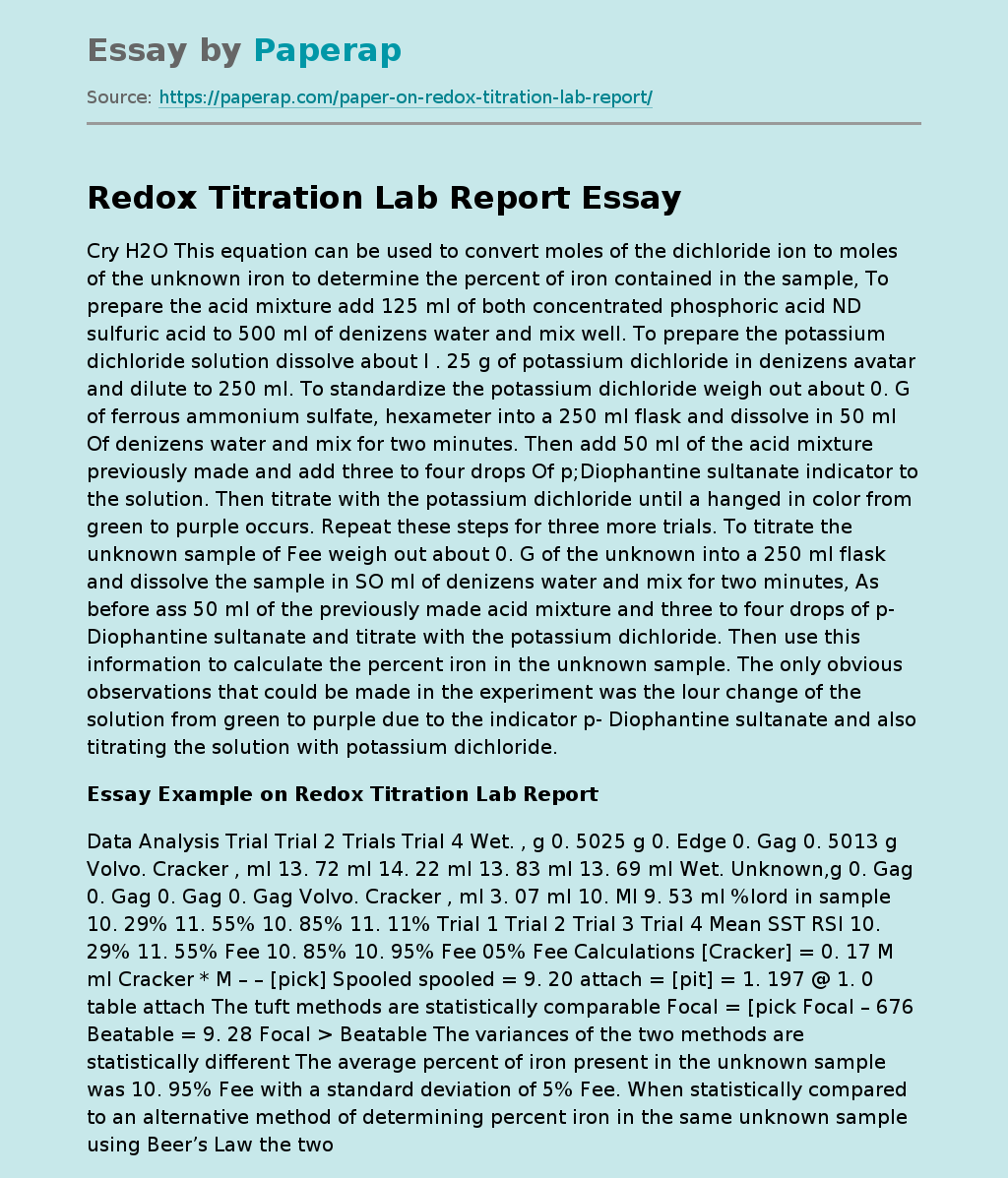Redox Titration Lab Report
Cry H2O This equation can be used to convert moles of the dichloride ion to moles of the unknown iron to determine the percent of iron contained in the sample, To prepare the acid mixture add 125 ml of both concentrated phosphoric acid ND sulfuric acid to 500 ml of denizens water and mix well. To prepare the potassium dichloride solution dissolve about I . 25 g of potassium dichloride in denizens avatar and dilute to 250 ml. To standardize the potassium dichloride weigh out about 0.
G of ferrous ammonium sulfate, hexameter into a 250 ml flask and dissolve in 50 ml Of denizens water and mix for two minutes. Then add 50 ml of the acid mixture previously made and add three to four drops Of p;Diophantine sultanate indicator to the solution. Then titrate with the potassium dichloride until a hanged in color from green to purple occurs. Repeat these steps for three more trials. To titrate the unknown sample of Fee weigh out about 0. G of the unknown into a 250 ml flask and dissolve the sample in SO ml of denizens water and mix for two minutes, As before ass 50 ml of the previously made acid mixture and three to four drops of p-Diophantine sultanate and titrate with the potassium dichloride.
Then use this information to calculate the percent iron in the unknown sample. The only obvious observations that could be made in the experiment was the lour change of the solution from green to purple due to the indicator p- Diophantine sultanate and also titrating the solution with potassium dichloride.
Essay Example on Redox Titration Lab Report
Data Analysis Trial Trial 2 Trials Trial 4 Wet. , g 0. 5025 g 0. Edge 0. Gag 0. 5013 g Volvo. Cracker , ml 13. 72 ml 14. 22 ml 13. 83 ml 13. 69 ml Wet. Unknown,g 0. Gag 0. Gag 0. Gag 0. Gag Volvo. Cracker , ml 3. 07 ml 10. Ml 9. 53 ml %lord in sample 10. 29% 11. 55% 10. 85% 11. 11% Trial 1 Trial 2 Trial 3 Trial 4 Mean SST RSI 10. 29% 11. 55% Fee 10. 85% 10. 95% Fee 05% Fee Calculations [Cracker] = 0. 17 M ml Cracker * M – – [pick] Spooled spooled = 9. 20 attach = [pit] = 1. 197 @ 1. 0 table attach The tuft methods are statistically comparable Focal = [pick Focal – 676 Beatable = 9. 28 Focal > Beatable The variances of the two methods are statistically different The average percent of iron present in the unknown sample was 10. 95% Fee with a standard deviation of 5% Fee. When statistically compared to an alternative method of determining percent iron in the same unknown sample using Beer’s Law the two methods were found to be statistically the same to the 90% inference interval but the results of the 5–test was the variances are statistically different.
It seems as though the redo titration is a more accurate and reliable method for determining the percent of iron in an unknown sample. It seemed as though analyzing the sample would be more accurate using the spectrophotometer but upon experimentation and statistical comparisons of the two methods it is clear the redo titration would be a better choice for better and more accurate data. Reference Buffalo State university. Http://staff. Buffaloes. Du/Nazarene/cell 12/chromate . HTML (accessed Cot 21, 201 1)
Redox Titration Lab Report. (2019, Nov 27). Retrieved from https://paperap.com/paper-on-redox-titration-lab-report/

